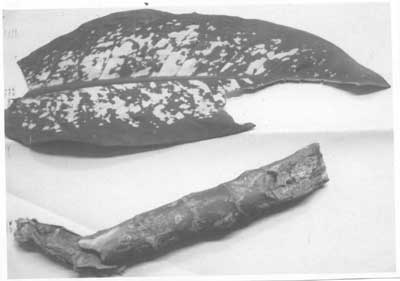Accidental ingestion of plants and seeds by children are not uncommon
and can result in significant symptoms necessitating hospital admission
and emergency treatment. Indian data on the exact proportion of
poisoning due to these toxic plants are not available. The Araceae
family of plants is the major cause of symptomatic plant ingestions in
some developed countries (Dieffenbachia and Philodendron)
and in Zimbabwe (Elephant’s Ear), especially in children [1]. A case of
Dieffenbachia plant (Dumb cane) ingestion followed by severe
tongue swelling is presented.
A nine-year-old boy was brought to the emergency
department with history of severe irritation and pain in the mouth with
difficulty in swallowing and drooling of saliva. The onset was acute,
subsequent to chewing of a portion of a leaf and the stem of a nearby
plant accidentally while playing in a park. Child’s parents attributed
the symptoms to this incident and carried both the leaf and the stem to
the emergency department (Fig. 1). On examination the boy
had severe pain in the mouth and throat with dysphagia. There was no
compromise of airway. He had severe upper abdominal pain also. Within a
span of one hour, he developed extensive erythema of the mucus membrane
of the mouth and throat with severe swelling of the tongue. The plant
was identified as Dieffenbachia and the clinical profile observed
matched with the consumption of the leaf of this toxic ornamental plant.
 |
|
Fig. 1 Dieffenbachia plant leaf and the
stem.
|
The boy was admitted and treated with intravenous
fluids, analgesics, antacid, antihistaminic and ranitidine. He was not
able to take anything orally for two days. From third day onwards, the
swelling and the redness of the tongue reduced, pain abdomen subsided
and he was able to tolerate liquid diet. Whitish grey slough that had
formed started disappearing from the tongue gradually, leaving
erythematous, sore areas. He made uneventful recovery and was discharged
after four days.
Ingestions involving the Dieffenbachia plant
from Arum family are associated with the development of intense
irritation of mucous membranes, resulting in swelling of the tongue,
lips and palate. Dieffenbachia causes severe local injury to the
tissues due to the oxalate crystals contained in the plant juice. In
severe cases there may be even airway compromise. Among 188 cases of
toxic plant ingestions identified by Mrvos, et al.[2], the
integrity of the leaf had been broken in all cases and dieffenbachias
accounted for 32.5% of the cases. Majority of the involved children were
aged 4-12 months. Only 2.1% (4 cases, Dieffenbachia-3,
Philoden-dron-1) of the patients were severely symptomatic [2]. In a
series from Switzerland, Dieffenbachia poisoning accounted for 11
cases with severe stomatitis in eight and corneal lesions in three
patients [3].
When ingested, the common house plant dieffenbachia
can lead to significant toxicity and possibly death if timely medical
attention is not forthcoming following initial exposure. The deleterious
effects should not be overlooked, especially when children are involved
who may bite into this innocuous looking plant [4]. Close observation is
required to prevent progressive swelling of tongue and adjacent tissues
interfering with the airway. Educating the people about the toxicity of
Dieffenbachia is crucial in view of the wide spread indoor use of
this ornamental plant.
1. Tagwireyi D, Ball DE. The management of Elephant’s
Ear poisoning. Hum Exp Toxicol. 2001;20:189-92.
2. Mrvos R, Dean BS, Krenzelok EP.
Philodendron/dieffenbachia ingestions: are they a problem? J Toxicol
Clin Toxicol. 1991;29:485-91.
3. Jaspersen-Schib R, Theus L, Guirguis-Oeschger M,
Gossweiler B, Meier-Abt PJ. Serious plant poisonings in Switzerland
1966-1994. Case analysis from the Swiss Toxicology Information Center.
Schweiz Med Wochenschr. 1996;126:1085-98.
4. Pamies RJ, Powell R, Herold AH, Martinez J. The dieffenbachia
plant. J Fla Med Assoc. 1992;79:760-1.

